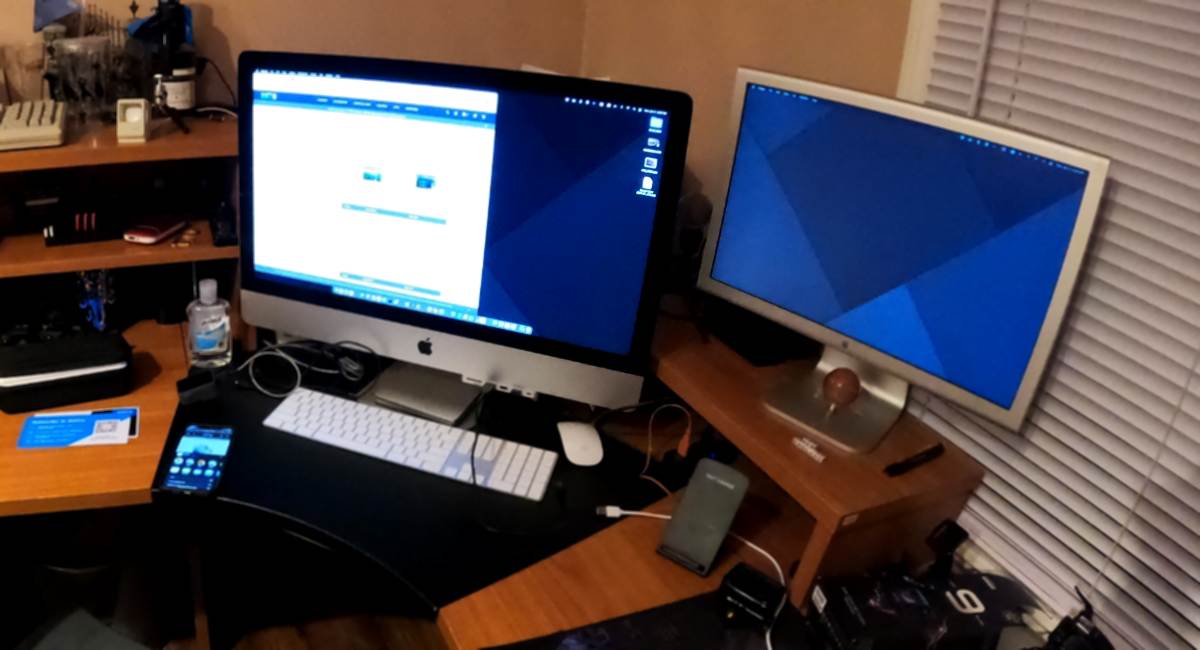External Monitor for iMac
My Home iMac Setup
As technology progresses, so does our desire for seamless connectivity and enhanced productivity. However, sometimes we encounter compatibility challenges when attempting to connect older devices with newer ones. One such example is using an Apple Cinema Display with an iMac, which relies on the newer USB-C ports. In this blog post, we'll explore the solution of using a USB-C to DVI adapter to bridge the gap between the two, while acknowledging the trade-off of utilizing one of the precious USB-C ports on the iMac.

Understanding the Challenge
Apple's Cinema Display is a renowned monitor known for its exceptional color accuracy, vibrant visuals, and sleek design. However, the newer generation of iMacs has transitioned to versatile USB-C ports, leaving many Cinema Display owners seeking a solution to connect their beloved monitors to the updated iMac models.
The USB-C to DVI Adapter
To address this compatibility issue, an effective solution lies in the form of a USB-C to DVI adapter. This adapter acts as a bridge between the USB-C port on the iMac and the DVI input on the Cinema Display, allowing users to enjoy the benefits of both devices without investing in a new monitor or compromising on the computing power of their iMac.
For my setup I have been using the Benfei USB C to DVI Adapter, Type-C to DVI Adapter for 3-years with no issues.
Benefits of the USB-C to DVI Adapter
Cost-effective Solution: Purchasing a new monitor can be a substantial investment. By utilizing a USB-C to DVI adapter, users can extend the life of their Apple Cinema Display and avoid unnecessary expenses.
Uncompromised Visual Quality: The DVI standard supports high-resolution displays, ensuring that your Apple Cinema Display retains its exceptional visual quality when connected to an iMac using the adapter. This means that you can continue to experience the vibrant colors, sharp details, and immersive visuals that the Cinema Display is known for.
Versatile Connectivity: In addition to connecting your Cinema Display to an iMac, the USB-C to DVI adapter can also be used to connect other devices equipped with a USB-C port to DVI monitors, projectors, or even televisions. This versatility allows you to maximize the use of your adapter across multiple devices and scenarios.
Drawbacks of Utilizing a USB-C Port
While the USB-C to DVI adapter provides a solution to connect your Apple Cinema Display to an iMac, it's important to acknowledge the downsides of using one of the USB-C ports on your iMac:
Reduced USB-C Port Availability: iMacs typically feature a limited number of USB-C ports. By utilizing one of these ports for the adapter, you may have fewer available ports for other peripherals or accessories. This limitation could impact your ability to connect additional devices, such as external hard drives, smartphones, or USB-C hubs.
Potential Dongle Clutter: Depending on your specific setup, using a USB-C to DVI adapter might contribute to a slightly cluttered workspace due to the presence of additional cables and adapters. While this may not be a significant issue, it's worth considering the aesthetics and tidiness of your workspace.

Conclusion
The USB-C to DVI adapter offers a viable solution for connecting an Apple Cinema Display to an iMac, allowing you to leverage the exceptional visual quality of the monitor without the need for a new display. Despite the drawbacks of utilizing one of the limited USB-C ports on your iMac, the benefits of retaining your Cinema Display's excellence and avoiding unnecessary expenses make this solution appealing to many users.
Before making a decision, consider your specific needs, the available USB-C ports on your iMac, and how this solution aligns with your overall workflow. By thoughtfully weighing the pros and cons, you can make an informed choice.
